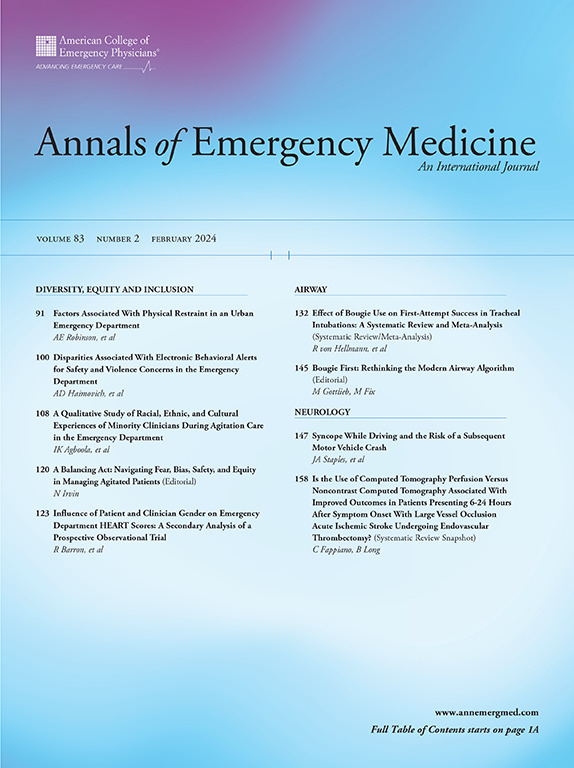Association of Two Preoxygenation Approaches With Hypoxemia During Tracheal Intubation: A Secondary Analysis.
IF 5
1区 医学
Q1 EMERGENCY MEDICINE
引用次数: 0
Abstract
STUDY OBJECTIVES Oxygen masks (bag-valve-mask device and nonrebreathing facemask oxygen) are the most common method of preoxygenation in critically ill patients undergoing emergency tracheal intubation in the emergency department and intensive care unit. Whether the type of oxygen mask used for preoxygenation alters the risk of hypoxemia during intubation is uncertain. We sought to compare the incidence of hypoxemia during intubation in patients preoxygenated with a bag-valve-mask device to the incidence of hypoxemia in patients preoxygenated with facemask oxygen. METHODS We conducted a secondary analysis of 2 randomized trials of emergency tracheal intubation. The primary outcome of hypoxemia was defined as a peripheral oxygen saturation <85% between induction of anesthesia and 2 minutes after tracheal intubation. We used a propensity-weighted multivariable logistic regression model to compare the incidence of hypoxemia between groups. We hypothesized that preoxygenation with a bag-valve-mask device would be associated with a lower incidence of hypoxemia compared to preoxygenation with facemask oxygen. RESULTS We included 1,156 patients in this analysis, of whom 136 were preoxygenated with a bag-valve-mask device and 1,020 were preoxygenated with facemask oxygen. Hypoxemia occurred in 20 of 136 (14.7%) participants in the bag-valve-mask device group and 153 of 1,020 (15.0%) participants in the facemask oxygen group. In the multivariable analysis, participants preoxygenated with a bag-valve-mask device had similar odds of hypoxemia to those preoxygenated with facemask oxygen (adjusted odds ratio 1.22, 95% confidence interval 0.72 to 2.16). CONCLUSION In critically ill patients undergoing tracheal intubation, preoxygenation with a bag-valve-mask device did not reduce the risk of hypoxemia compared to preoxygenation with facemask oxygen.两种预充氧途径与气管插管期间低氧血症的关联:二次分析。
研究目的氧气面罩(气囊-瓣膜-面罩装置和无呼吸面罩氧气)是急诊科和重症监护病房急诊气管插管危重患者最常用的预充氧方法。用于预充氧的氧气面罩类型是否会改变插管期间低氧血症的风险尚不确定。我们试图比较使用气囊面罩装置预充氧的患者插管期间低氧血症的发生率与使用面罩预充氧的患者低氧血症的发生率。方法对2例急诊气管插管随机试验进行二次分析。低氧血症的主要结局定义为麻醉诱导至气管插管后2分钟外周氧饱和度<85%。我们使用倾向加权多变量logistic回归模型来比较各组之间低氧血症的发生率。我们假设,与面罩预充氧相比,使用气囊瓣膜面罩预充氧可降低低氧血症的发生率。结果我们纳入了1156例患者,其中136例使用气囊-瓣膜-面罩装置预充氧,1020例使用面罩预充氧。低氧血症发生在136名受试者中的20名(14.7%)和1020名受试者中的153名(15.0%)。在多变量分析中,使用气囊-瓣膜-面罩装置预充氧的参与者与使用面罩预充氧的参与者发生低氧血症的几率相似(调整优势比1.22,95%置信区间0.72至2.16)。结论在气管插管危重患者中,与面罩预充氧相比,气囊-瓣膜-面罩预充氧不能降低低氧血症的发生风险。
本文章由计算机程序翻译,如有差异,请以英文原文为准。
求助全文
约1分钟内获得全文
求助全文
来源期刊

Annals of emergency medicine
医学-急救医学
CiteScore
8.30
自引率
4.80%
发文量
819
审稿时长
20 days
期刊介绍:
Annals of Emergency Medicine, the official journal of the American College of Emergency Physicians, is an international, peer-reviewed journal dedicated to improving the quality of care by publishing the highest quality science for emergency medicine and related medical specialties. Annals publishes original research, clinical reports, opinion, and educational information related to the practice, teaching, and research of emergency medicine. In addition to general emergency medicine topics, Annals regularly publishes articles on out-of-hospital emergency medical services, pediatric emergency medicine, injury and disease prevention, health policy and ethics, disaster management, toxicology, and related topics.
 求助内容:
求助内容: 应助结果提醒方式:
应助结果提醒方式:


